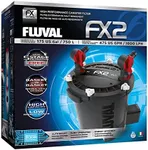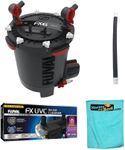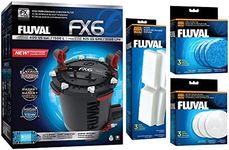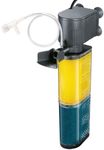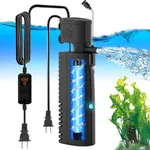Buying Guide for the Best Fluval Canister Filters
Choosing the right canister filter for your aquarium is crucial for maintaining a healthy and clean environment for your aquatic life. Canister filters are known for their efficiency and versatility, making them a popular choice among aquarium enthusiasts. When selecting a canister filter, it's important to consider several key specifications to ensure it meets the needs of your specific aquarium setup. Understanding these specs will help you make an informed decision and keep your tank in optimal condition.Flow RateFlow rate refers to the amount of water the filter can process in a given time, usually measured in gallons per hour (GPH). This spec is important because it determines how effectively the filter can clean your tank. For smaller tanks (up to 20 gallons), a flow rate of 100-200 GPH is typically sufficient. Medium tanks (20-50 gallons) may require 200-400 GPH, while larger tanks (over 50 gallons) might need 400 GPH or more. Choose a flow rate that matches the size of your tank to ensure efficient filtration without creating too much current for your fish.
Filter Media CapacityFilter media capacity indicates the amount of space available for different types of filter media (mechanical, chemical, and biological). This is important because a larger capacity allows for more comprehensive filtration, improving water quality. Smaller tanks may not need as much media capacity, while larger tanks benefit from having more space for diverse media types. Consider the size of your tank and the types of media you plan to use when evaluating this spec.
Ease of MaintenanceEase of maintenance refers to how simple it is to clean and maintain the filter. This is crucial because regular maintenance is necessary to keep the filter functioning properly. Some filters have features like quick-release valves or easy-access compartments that make maintenance more convenient. If you prefer a low-maintenance option, look for filters with these user-friendly features. Your willingness and ability to perform regular maintenance should guide your choice here.
Noise LevelNoise level indicates how much sound the filter produces while operating. This is important if your aquarium is in a living space where noise could be disruptive. Filters are generally categorized as quiet, moderate, or loud. If you need a quiet environment, opt for a filter known for its silent operation. Consider where your aquarium is located and how much noise you can tolerate when choosing a filter.
Energy EfficiencyEnergy efficiency refers to how much power the filter consumes. This is important for both environmental and cost reasons. More energy-efficient filters will use less electricity, which can save you money on your utility bills and reduce your environmental footprint. Look for filters with energy-saving features if this is a priority for you. Your concern for energy consumption and cost should guide your decision in this area.
Durability and Build QualityDurability and build quality refer to how well the filter is constructed and how long it is likely to last. This is important because a well-built filter will provide reliable performance and require fewer replacements. Filters made from high-quality materials and with solid construction are generally more durable. Consider the reputation of the brand and user reviews to gauge the durability of a filter. If you want a long-lasting solution, prioritize build quality in your selection.

